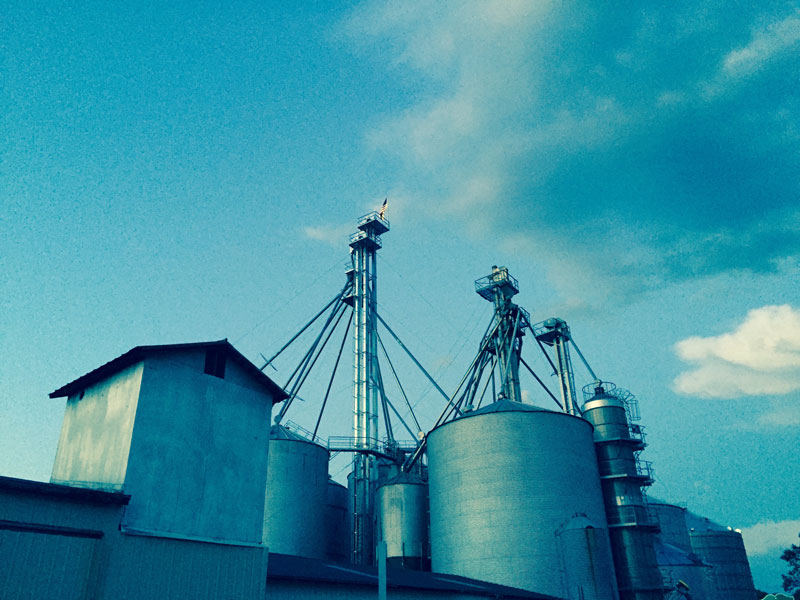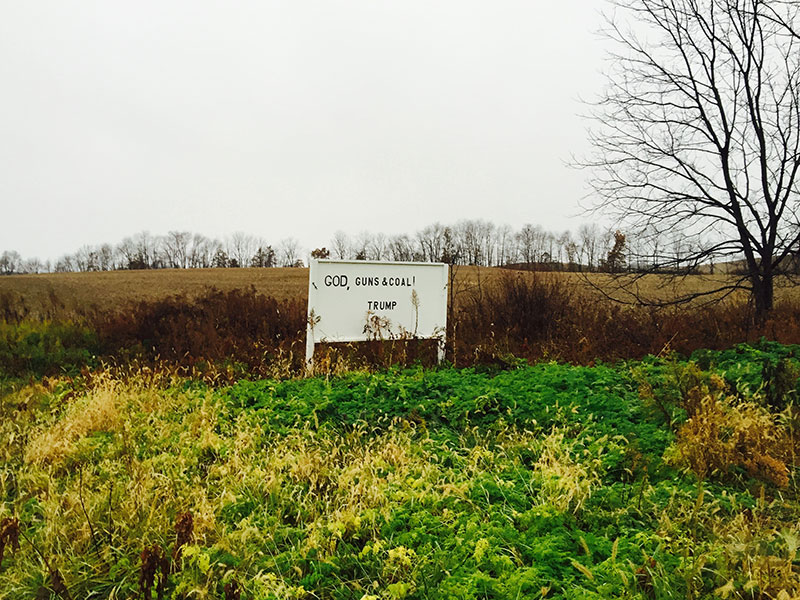Editorial Note: Last week I reached out to three writers and asked them to write stories in the context of the 2016 election–what’s next for our political landscape, economy, environment, and media? I’m joined by some good folks who are volunteering their skills to help get this thing quickly off the ground. Super special thank you to Aaron Fuleki. And big nods to Martin Anderson, Noah Wood, James Weaver, Cynthia Greenleaf, and Margot Singer for photography and editing.
The day after the 2016 election, the New York Times ran a story about how the media got it all wrong.
“No shit,” thought everyone in the world.
In the months before the election, I passed dozens of homemade “Trump for President” signs as I drove my little blue Ranger around Licking, Knox, and Fairfield Counties. It seemed to me then indicative of grassroots support for Trump—perhaps a portent of things to come.
There was one that read “Trump—Best for USA,” with red, white, and blue paint on a large piece of plywood attached to an electrical pole on Highway 33 in Athens County, Ohio. Outside Wolf Lake, Indiana, “Save America from Socialism, Elect Trump-Spence” in spray-painted black letters on the side of a silver trailer. Another read “Trump—Pray for our Nation. Take Our Country Back” on a large piece of plywood painted black, just south of Dalton, Georgia. And just up the road on Highway 62 in Knox County, in the midst of Amish country, “God, Guns, and Coal. Trump.”
Save for a few stories about individual signs, no one put the pieces together. Maybe there was meaning there? Did the signs indicate a kind of grassroots activism connected to the Trump campaign? Maybe. Maybe not. But it didn’t make the headlines.
For the past few months I’ve been pitching stories like that about my corner of Ohio to east coast editors who’ve said, on more than one occasion, “I don’t see the national import of X, Y, or Z story.”
For example, the story of an Ohio woman whose neighbor had recently raised a Confederate flag. She said she was very afraid. She’s black. He’s white. Or the story of how homeless and “marginally housed” people in a Rust Belt city experienced the election cycle and whether or not they planned to vote and for whom.
It’s not entirely the media’s fault. Print newspapers—the traditional realm of shoe-leather reporting—aredying. That’s not . . . news. Nonprofit investigative outfits have picked up some of the slack, but there’s a lot of slack to pick up.
Those homemade Trump signs and the people who took the time to construct them were and are a valuable story.
But I think there are many valuable stories in the places where these signs popped up.
There’s value in stories about Eric Lee, a man who served twenty years in prison, who is in recovery, and who, every day, focuses on helping others. In the past three weeks I’ve watched Eric counsel five different people in Newark, Ohio, help them think through their recovery, help them find housing, help them find work. Eric doesn’t get paid for this work. He just does it.
There’s value in learning about Homer, Ohio, the birthplace of Victoria Woodhull, the first woman to run for president. And it’s not just in the fact that she was born there, but because Homer, Ohio, is a place full of people who care about it. And ten years ago the town lost its public school. Since then it has struggled to find an identity.
And there’s value in learning about unemployment, marginal housing, drug addiction, mental illness, and hunger. There’s value in knowing how people can manage in a culture that mostly praises “bootstrapping” and pities the poor—or, worse, blames them for their poverty. And there’s value in learning about the activists who are taking on these problems.

The middle, the vast spaces between New York and Los Angeles, the flyover country, is full of people who are very much in touch.
So, for all y’all who were surprised by the outcome of this year’s presidential election (and those who weren’t), for those of you who recognize that you might be out of touch with what’s going on in “Flyover Country” (beyond the echo chambers of Los Angeles and New York or your Facebook feed), for those of you looking to connect with progressive people in these places, this will be your place.
Between Coasts is about original, thought-provoking, and empathetic narrative nonfiction. Between Coasts is a new model of community-based but nationally and internationally focused journalism that will produce stories from and about Trumpland.
These are our core principles:
- Micro journalism with a macro perspective: What’s happening locally is linked to bigger things. The soybeans grown in Licking County, Ohio, are more than likely exported to China, Japan, or Taiwan.
- No parachuting: We want journalism that’s rooted in a place and written by the people who live there. We’ll look for writers based in the places they’re writing about or who know them well and can write about them with a national audience in mind. There will be no writers based out of New York, Los Angeles, Boston, or our nation’s capital. Apologies. If Between Coasts writers do report on something happening in places other than their hometowns, they’ll let the locals do the talking. They’ll let them tell us about their place, their lives, not the other way around.
- Slow journalism matters: We’ll spend time with a story, a subject. Every week people like Eric Lee do something interesting. We’ll write about that.
- Empathetic journalism: We’ll value nonfiction writing and research that tries to understand the lives of other people—however impossible that may be. We want to cover stories about the lives of people living in counties that voted for Trump. This administration will create policies that will affect people’s lives. And as with most things coming from the top down, it’s a good guess that women, people of color, the poor, and LGBTQ+ will suffer the most. To counter this, people are organizing and protesting. What does that look like? What will that look like?
- No Shouting but…: Because we’ll privilege narrative and slow journalism we’ll avoid shouting if at all possible. But when politicians try to cover up violence with lies, with euphemisms, we will shout. George Orwell writes in “Politics and the English Language” that official policy can disguise the truth: “A mass of Latin words falls upon the facts like soft snow, blurring the outline and covering up all the details. The great enemy of clear language is insincerity. When there is a gap between one’s real and one’s declared aims, one turns as it were instinctively to long words and exhausted idioms, like a cuttlefish spurting out ink. In our age there is no such thing as ‘keeping out of politics’. All issues are political issues, and politics itself is a mass of lies, evasions, folly, hatred, and schizophrenia. When the general atmosphere is bad, language must suffer.”
The general atmosphere is bad, friends, but language need not suffer. It must get tough.
We must get tough.

